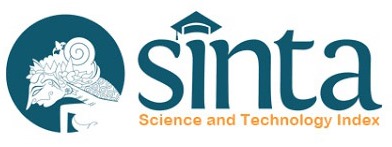Serbuk-Penyedap Rasa dari Alam: Ekstrak Kaldu dari Cangkang Udang Segar (L. vannamei) menggunakan Refluk Berbantuan Bromelain
Abstract
Limbah cangkang udang menimbulkan permasalahan polusi udara dan tumpukan sampah yang dihinggapi lalat. Pemanfaatan cangkang udang yang kaya protein dapat diekstraksi untuk dimanfaatkan sebagai serbuk penyedap rasa. Penelitian ini dilakukan untuk menentukan karakteristik dari filtrat ekstrak cangkang udang segar dan produk serbuk rasa udang, serta menentukan kondisi ekstraksi yang optimal pada penggunaan konsentrasi bromelain dan waktu refluk. Metode yang digunakan untuk pengambilan ekstrak udang dengan cara ekstraksi dengan alat refluk yang dilengkapi dengan pendingin yang terbagi menjadi dua tahap yaitu penambahan larutan garam dan enzim bromelain Gabungan filtrat ekstraksi dianalisis menggunakan GC-MS dan FT-IR. Selanjutnya filtrat diformulasikan menjadi serbuk penyedap rasa udang dengan beberapa bahan tambahan berupa tepung dan rempah-rempah. Selanjutnya, serbuk penyedap rasa dianalisis kadar air dan TEM. Ekstrak cangkang udang segar yang dianalsis mengandung senyawa dimetilamina dan trimetilamina yang merupakan kandungan protein, dengan kadar protein mencapai 28,984%. Selain protein, ekstrak juga mengandung asam lemak cangkang udang. Serbuk penyedap rasa udang yang dihasilkan mempunyai ukuran partikel sebesar 5 s.d 25 nm, dengan kadar air 11,11%. Kondisi operasi optimal ekstraksi protein dengan metode refluk pada kombinasi konsentrasi 2% katalis enzim bromelain pada suhu refluks 55 °C selama 1,5 jam. Ekstraksi menggunakan enzim bromelain secara bertahap memberikan kualitas flavor udang berupa serbuk kandungan protein dan lemak udang yang dipadu menjadi cita rasa spesifik dengan ukuran nanometer.
Abstract
Shrimp shell waste causes air pollution problems and piles of garbage that flies infest. The utilization of shrimp shells rich in protein can be extracted to be used as flavouring powder. This research was conducted to determine the characteristics of fresh shrimp shell extract filtrate and shrimp flavour powder product and the optimal extraction conditions using bromelain concentration and reflux time. The method used for extracting shrimp extract through extraction with a reflux tool equipped is divided into two stages adding a salt solution and bromelain enzyme. The mixed filtrate was analyzed using GC-MS and FT-IR. The filtrate is formulated into shrimp flavouring powder with some additional ingredients in the form of flour and spices. The flavouring powder was analyzed for water content and TEM. The fresh shrimp shell extracts analyzed containing dimethylamine and trimethylamine compounds which are protein content, with protein content reaching 28.984%. In addition to protein, the extract also contains fatty acids in shrimp shells. The resulting shrimp flavouring powder has a particle size of 5 to 25 nm, with a moisture content of 11.11%. Optimal operating conditions for protein extraction by reflux were method at a combined concentration of 2% bromelain enzyme catalyst at a reflux temperature of 55°C for 1.5 hours. Extraction using bromelain enzymes gradually gives shrimp flavour as a powder containing shrimp protein, combined into a specific taste with nanometer size.
Keywords
Full Text:
PDFReferences
Ambigaipalan, P., & Shahidi, F. (2017). Bioactive peptides from shrimp shell processing discards: Antioxidant and biological activities. Journal of Functional Foods, 34, 7-17. doi: 10.1016/j.jff.2017.04.013
Amiguet, V. T., Kramp, K. L., Mao, J., McRae, C., Goulah, A., Kimpe, L. E., Blais, J. M., & Arnason, J. T. (2012). Supercritical carbon dioxide extraction of polyunsaturated fatty acids from Northern shrimp (Pandalus borealis Kreyer) processing by-products. Food Chemistry, 130(4), 853-858. doi: 10.1016/j.foodchem.2011.07.098
Borzova, V. A., Markossian, K. A., Chebotareva, N. A., Kleymenov, S. Y., Poliansky, N. B., Muranov, K. O., Stein-Margolina, V.A., Shubin, V.V., Markov, D.I. & Kurganov, B. I. (2016). Kinetics of thermal denaturation and aggregation of bovine serum albumin. PloS one, 11(4), e0153495. doi: 10.1371/journal.pone.0153495
Bougatef A. (2013). Trypsins from fish processing waste: characteristics and biotechnological applications-comprehensive review. Journal of Cleaner Production. 57, 257–265. doi: 10.1016/j.jclepro.2013.06.005
Cai, L., Wang, Q., Dong, Z., Liu, S., Zhang, C., & Li, J. (2017). Biochemical, nutritional, and sensory quality of the low salt fermented shrimp paste. Journal of Aquatic Food Product Technology, 26(6), 706-718. doi:10.1080/10498850.2016.1276111
Dayakar, B., Xavier, K. M., Ngasotter, S., Layana, P., Balange, A. K., Priyadarshini, B., & Nayak, B. B. (2022). Characterization of spray-dried carotenoprotein powder from Pacific white shrimp (Litopenaeus vannamei) shells and head waste extracted using papain: Antioxidant, spectroscopic, and microstructural properties. LWT, 159, 113188. doi: 10.1016/j.lwt.2022.113188
Emorine, M., Septier, C., Martin, C., Cordelle, S., Sémon, E., Thomas-Danguin, T., & Salles, C. (2021). Salt and aroma compound distributions influence flavour release and temporal perception while eating hot-served flans. Molecules, 26(5), 1300. doi:10.3390/molecules26051300
Fu X., Zhu L., Li L., Zhang T., Li M., Mou H. (2019). Eco-friendly preparation of chitooligosaccharides with different degrees of deacetylation from shrimp shell waste and their effects on the germination of wheat seeds. Marine Life Science & Technology. (1), 95–103. doi:10.1007/s42995-019-00012-3
Gbenebor, O. P., Adeosun, S. O., Lawal, G. I., Jun, S., & Olaleye, S. A. (2017). Acetylation, crystalline and morphological properties of structural polysaccharide from shrimp exoskeleton. Engineering Science and Technology, an International Journal, 20(3), 1155-1165. doi: 10.1016/j.jestch.2017.05.002
Hamid, M. A., Wang, X., & Zhao, X. (2013). Measurement of trimethylamine contents and evaluation of pig meat natural quality by spectrophotometric method. Scientific Research and Essays, 8(47), 2281-2288. doi:10.5897/SRE11.2195
Haque, R., Sawant, P. B., Sardar, P., Xavier, K. M., Varghese, T., Chadha, N. K., Pattanaik, S. S, Jana, P. & Naik, V. A. (2021). Synergistic utilization of shrimp shell waste-derived natural astaxanthin with its commercial variant boosts physio metabolic responses and enhances colouration in discus (Symphysodon aequifasciatus). Environmental Nanotechnology, Monitoring & Management, 15, 100405. doi: 10.1016/j.enmm.2020.100405
Hongkulsup, C., Khutoryanskiy, V. V., & Niranjan, K. (2016). Enzyme assisted extraction of chitin from shrimp shells (Litopenaeus vannamei). Journal of Chemical Technology & Biotechnology, 91(5), 1250-1256. doi:10.1002/jctb.4714
Kim Y., Park R. D. (2015). Progress in bioextraction processes of chitin from crustacean biowastes. Journal of the Korean Society for Applied Biological Chemistry, 58 545–554. doi:10.1007/s13765-015-0080-4
Kimbuathong, N., Leelaphiwat, P., & Harnkarnsujarit, N. (2020). Inhibition of melanosis and microbial growth in Pacific white shrimp (Litopenaeus vannamei) using high CO2 modified atmosphere packaging. Food Chemistry, 312, 126114. doi: 10.1016/j.foodchem.2019.126114
Kumar, M., Tomar, M., Potkule, J., Verma, R., Punia, S., Mahapatra, A., Belwal, T., Dahuja, A., Joshi, S., Berwal, M. K., Sarankar, V., Bhoite, A. G., Kaur, C., & Kennedy, J. F. (2021). Advances in the plant protein extraction: Mechanism and recommendations. Food Hydrocolloids, 115, 106595. doi: 10.1016/j.foodhyd.2021.106595
Li, H., Zheng, R., Zuo, F., Qian, C., Yao, Z., Dong, R., Zhao, D., & Li, C. (2022). Influence of Proteolysis on the Binding Capacity of Flavor Compounds to Myofibrillar Proteins. Foods, 11(6), 891. doi:10.3390/foods11060891
Liu, Z., Liu, Q., Wei, S., Sun, Q., Xia, Q., Zhang, D., Shi., W., Ji, H & Liu, S. (2021). Quality and volatile compound analysis of shrimp heads during different temperature storage. Food chemistry: X, 12, 100156. doi: 10.1016/j.fochx.2021.100156
Lorido, L., Pizarro, E., Estévez, M., & Ventanas, S. (2019). Emotional responses to the consumption of dry-cured hams by Spanish consumers: A temporal approach. Meat science, 149, 126-133. doi: 10.1016/j.meatsci.2018.11.015
Martins, B. C., Rescolino, R., Coelho, D. F., Zanchetta, B., Tambourgi, E. B., & Silveira, E. (2014). Characterization of bromelain from ananas comosus agroindustrial residues purified by ethanol factional precipitation. Chemical engineering transactions, 37, 781-786. doi:10.3303/CET1437131
Mizani, M. A. R. Y. A. M., Aminlari, M., & Khodabandeh, M. (2005). An effective method for producing a nutritive protein extract powder from shrimp-head waste. Food science and technology international,11(1), 49-54. doi: 10.1177/1082013205051271
Mohan, R., Sivakumar, V., Rangasamy, T., & Muralidharan, C. (2016). Optimisation of bromelain enzyme extraction from pineapple (Ananas comosus) and application in process industry. American Journal of Biochemistry and Biotechnology, 12(3), 188-195. doi:10.3844/ajbbsp.2016.188.195
Nanda, E. V., Pratiwi, Y., & Putri, E. R. (2022, July). Characteristic and Photostability of Astaxanthin Extract from Shrimp Shells by Microwave Assisted Extraction Using Nades Solvent. In Journal of Physics: Conference Series (Vol. 2309, No. 1, p. 012036). IOP Publishing. doi: 10.1088/1742-6596/2309/1/012036
Pattanaik, S. S., Sawant, P. B., KA, M. X., Srivastava, P. P., Dube, K., Sawant, B. T., & Chadha, N. K. (2021). Dietary carotenoprotien extracted from shrimp shell waste augments growth, feed utilization, physio-metabolic responses and colouration in Oscar, Astronotus ocellatus (Agassiz, 1831). Aquaculture, 534, 736303. doi: 10.1016/j.aquaculture.2020.736303
Pattanaik, S. S., Sawant, P. B., Xavier, K. M., Dube, K., Srivastava, P. P., Dhanabalan, V., & Chadha, N. K. (2020). Characterization of carotenoprotein from different shrimp shell waste for possible use as supplementary nutritive feed ingredient in animal diets. Aquaculture, 515, 734594, doi:10.1016/j.aquaculture.2019.734594
Płotka-Wasylka, J., Rutkowska, M., Owczarek, K., Tobiszewski, M., & Namieśnik, J. (2017). Extraction with environmentally friendly solvents. TrAC Trends in Analytical Chemistry, 91, 12-25. doi: 10.1016/j.trac.2017.03.006
Poonsin, T., Simpson, B. K., Benjakul, S., Visessanguan, W., & Klomklao, S. (2017). Albacore tuna (Thunnus alalunga) spleen trypsin partitioning in an aqueous two-phase system and its hydrolytic pattern on Pacific white shrimp (Litopenaeus vannamei) shells. International Journal of Food Properties, 20(10), 2409-2422. doi:10.1080/10942912.2016.1240180
Prasetyaningsih, A., Najoan, G. C., Wisaksono, A., & Rahardjo, D. (2021). Ekstraksi Astaxanthin Kulit Udang (Litopenaeus vannamei) Pantai Gunung Kidul Menggunakan Pelarut Minyak Bunga Matahari dan Etanol. Jurnal Ilmiah Biosaintropis (Bioscience-Tropic), 7(1), 33-43. doi: 10.33474/e-jbst.v7i1.384
Raghavan, S. (2006). Handbook of spices, seasonings, and flavorings. CRC press
Rengga, W. D. P., Salsabiil, K. A., Oktavia, S. E., & Ansori, M. (2019, November). Flavored powder from shrimp shells with bromelain enzymatic process and adding of flour and spices. In Journal of Physics: Conference Series (Vol. 1367, No. 1, p. 012080). IOP Publishing. doi: 10.1088/1742-6596/1367/1/012080
Robinson, P. K. (2015). Enzymes: principles and biotechnological applications. Essays in biochemistry, 59, 1.
Rodrigues, R. C., Ortiz, C., Berenguer-Murcia, Á., Torres, R., & Fernández-Lafuente, R. (2013). Modifying enzyme activity and selectivity by immobilization. Chemical Society Reviews, 42(15), 6290-6307. doi: 10.1039/c2cs35231a
Setiati, R., Siregar, S., Wahyuningrum, D., & Rinanti, A. (2021, April). Synthesis method of chitin become chitosan polymer from shrimp shells for enhanced oil recovery. In IOP Conference Series: Earth and Environmental Science (Vol. 737, No. 1, p. 012048). IOP Publishing. doi:10.1088/1755-1315/737/1/012048
Sowmya, R., & Sachindra, N. M. (2012). Evaluation of antioxidant activity of carotenoid extract from shrimp processing by-products by in vitro assays and in membrane model system. Food Chemistry, 134(1), 308-314. doi: 10.1016/j.foodchem.2012.02.147
Suryawanshi, N., Ayothiraman, S., & Eswari, J. S. (2020). Ultrasonication mode for the expedition of extraction process of chitin from the maritime shrimp shell waste. Indian Journal of Biochemistry and Biophysics (IJBB), 57(4), 431-438. doi: 10.56042/ijbb.v57i4.29626
Tahmaz, J., Begić, M., Oručević Žuljević, S., Mehmedović, V., Alkić-Subašić, M., Jurković, J., & Djulanćić, N. (2022, May). In 10th Central European Congress on Food: Proceedings of CE-Food 2020 (pp. 14-32). doi:10.1007/978-3-031-04797-8_2
Trnková, L., Dršata, J., & Boušová, I. (2015). Oxidation as an important factor of protein damage: Implications for Maillard reaction. Journal of biosciences, 40(2), 419-439. doi:10.1007/s12038-015-9523-7
Wijayanti, I., Romadhon, R., & Rianingsih, L. (2016). Karakteristik Hidrolisat Protein Ikan Bandeng (Chanos chanos Forsk) dengan Konsentrasi Enzim Bromelin yang Berbeda Caracteristic of Milkfish (Chanos chanos Forsk) Protein Hydrolysate as effect of Different Bromelin Enzyme Concentration. Saintek Perikanan: Indonesian Journal of Fisheries Science and Technology, 11(2), 129-133. doi:10.14710/ijfst.11.2.129-133
Wyban, J. (2019). Selective breeding of Penaeus vannamei: impact on world aquaculture and lessons for future. Journal of Coastal Research, 86(SI), 1-5. https://doi.org/10.2112/ SI86-001.1
Xin, R., Wancui, X., Zhiying, X., Hongxia, C., Zuoxing, Z., and Xihong, Y. (2020). Efficient extraction of chitin from shrimp waste by mutagenized strain fermentation using atmospheric and room-temperature plasma. International Journal of Biological Macromolecules. 155, 1561–1568. doi: 10.1016/j.ijbiomac.2019.11.133
Younes, I., & Rinaudo, M. (2015). Chitin and chitosan preparation from marine sources. Structure, properties and applications. Marine drugs, 13(3), 1133-1174. doi: 10.3390/md13031133
DOI: https://doi.org/10.15578/jpbkp.v18i1.909
Refbacks
- There are currently no refbacks.
JPBKP adalah Jurnal Ilmiah yang terindeks :
ISSN : 1907-9133(print), ISSN : 2406-9264(online)
This work is licensed under a Creative Commons Attribution-NonCommercial-ShareAlike 4.0 International License.








